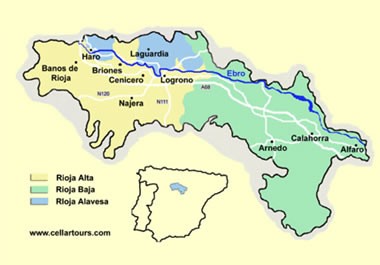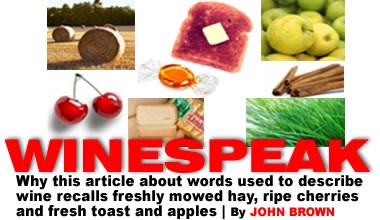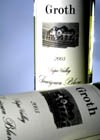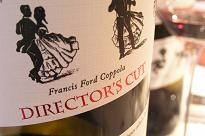Over the past several months, I have had the pleasure of tasting a number of excellent wines for all things WineBoy, including this blog, the "WineBoy" webcast and the “Main Ingredient” column in the Sunday Gazette-Mail. You may have seen the reviews of a few of these wines in the Main Ingredient, but in case you haven’t, you might want to look for these lovelies at your favorite wine shop or grocery store. Enjoy.
2006 Groth from Napa Valley ($17): This beauty combines the herbal and grassy flavors one expects from sauvignon blanc with a richer texture and fuller feel that should pair exceptionally well with a pasta and asparagus dish with bits of pancetta or bacon.
2005 Montirius Côtes du Rhône ($11): The southern Rhône Valley of France is known for chewy, juicy wines that exhibit a smoky, peppery quality. The most famous wine of the region is Châteauneuf-du-Pape, but there are other, more affordable options from that storied region. The Montirius is a lovely Côtes du Rhône red which is a blend of grenache, mourvèdre and syrah. This is a delicious wine chock-full of peppery, dark fruit flavors with a touch of smoke for good measure. Domaine Montirius is also one of the first French wineries to adopt organic and biodynamic practices in both the vineyard and winery. Try it with smoked chicken or grilled hamburgers.
2006 Nobilo Marlborough Sauvignon Blanc ($11) from New Zealand: Frank Nobilo made his fortune as a PGA touring pro, but, in my opinion, his best stroke was the establishment of the winery bearing his name. One of my favorite value wines is his ’06 sauvignon blanc. This is a crisp, refreshing sipper with a touch of melon and citrus and would be a great accompaniment to poached salmon sauced with dill infused mayonnaise.
 2003 Saladini Pilastri Pregio del Conte ($20): Pregio del Conte is a blend of Aglianico and Montepulciano. From the Marches region of Italy, this wine has concentrated sweet dark fruit flavors and is balanced by lively acidity. It would be an excellent choice with roasted sirloin of pork seasoned with garlic, kosher salt, coarsely ground black pepper and rosemary.
2003 Saladini Pilastri Pregio del Conte ($20): Pregio del Conte is a blend of Aglianico and Montepulciano. From the Marches region of Italy, this wine has concentrated sweet dark fruit flavors and is balanced by lively acidity. It would be an excellent choice with roasted sirloin of pork seasoned with garlic, kosher salt, coarsely ground black pepper and rosemary.
2006 Ballantine Chenin Blanc ($17): This remarkable estate-grown Napa Valley chenin blanc, produced from 25 year–old vines, is a myth-breaker. Why? Well, most chenin blanc, especially from the famous Loire Valley region of Vouvray, is finished slightly sweet, and is a lovely brunch or aperitif quaff. The ’06 Ballantine is an elegant, dry wine with citrus and mineral notes, a hint of toasty vanilla and a full-mouth feel. It is also crisp, balanced and would be a great match to a stir-fry of chicken, peanuts, onions and sweet red peppers with a touch of soy and a few drops of sesame oil..
 2005 Hedges CMS Red ($14): This Washington State meritage blend of almost equal parts cabernet sauvignon and merlot with about 6% syrah is a delicious, balanced and complex wine that is an absolute bargain. Washington wines, particularly cabernet and merlot, can be the equal to and, in some vintages, even exceed the wines of California and Bordeaux. The 2005 vintage was excellent and this wine reflects that quality. With a rich, mouth-coating cola and black currant flavor, this well-balanced wine is drinkable now, but will benefit from a few more years in the bottle. Serve it with roasted fillet of beef in a Bordelaise sauce.
2005 Hedges CMS Red ($14): This Washington State meritage blend of almost equal parts cabernet sauvignon and merlot with about 6% syrah is a delicious, balanced and complex wine that is an absolute bargain. Washington wines, particularly cabernet and merlot, can be the equal to and, in some vintages, even exceed the wines of California and Bordeaux. The 2005 vintage was excellent and this wine reflects that quality. With a rich, mouth-coating cola and black currant flavor, this well-balanced wine is drinkable now, but will benefit from a few more years in the bottle. Serve it with roasted fillet of beef in a Bordelaise sauce.
2005 White Knight Clarksburg Viognier ($17): Viognier does really well in almost arid conditions and in poorly drained soil. Sounds weird, I know. This Viognier was grown along the Sacramento River Delta near the town of Clarksburg (not WV). With floral aromas and apricot and peach flavors, the White Knight is a medium -bodied mouthful of wine. This wine is a very pleasing quaff and can be used as an aperitif or with lighter foods such as a cobb salad with a ranch-style dressing.
2005 Allegrini Valpolicella Classico ($17) –In the rolling hills of northeastern Italy just beyond Verona, the Allegrini family has been producing one of the best Valopolicella’s in that vine-rich nation. This wine is fruit-driven bottle with excellent cherry flavors and bright acidity to match nicely with lighter dishes such as an omelet or frittata made with eggs, provolone, onions, arugula and Italian sausage.







